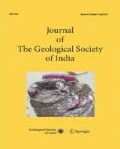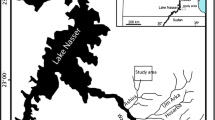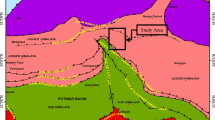Abstract
Petrological and geochemical characteristics of the granites from the Khanak and Devsar areas have been discussed in this paper. Based on field, petrographical and geochemical observations, three types of granites (grey, green and pink granite) have been identified in these areas. Grey granites consist of quartz, plagioclase, biotite, hornblende as essential minerals and hematite, zircon, annite, monazite & rutile as accessory minerals. Petrographically, green granites are same as grey granites including perthite and zircon as accessory minerals. Pink granites consist of quartz, k-feldspar and biotite in Khanak whereas in Devsar granites alike as Khanak granites, but plagioclase is replaced by perthite and occurs as dominantly. Microscopically, granites of both areas show porphyritic, hypidiomorphic, granophyric, perthitic and micro granophyric textures. Geochemically, major oxide elements (except alkalies) and trace elements (Ba, Sr, Cr, Ni, V, Cu, Zn, Ga, Pb, Th and Zr) are more in green and grey granites of Khanak and Devsar areas than pink granites. Generally, they show enrichments in SiO2, Na2O+K2O, Fe/Mg, Rb, Zr, Y and and AI (Agpaitic Index) (ranges from 0.10 to 1.18) and depletion in MgO, CaO, P, Ti, Ni, Cr and V indicate their A-type affinity which is very similar to the A-type granites of MIS (Malani igneous suite) in northwestern peninsular India. Green and grey granites of Devsar area show high concentrations of Heat production (HP) 9.68 & 11.70 μWm-3 and total Heat Generation Unit (HGU) i.e 23.04 & 27.86 respectively. On the other hand, pink granites of Khanak area display a higher enrichment of HP (16.53 μWm-3) and HGU (39.37) than those granites of Devsar area. Overall, they have much a higher values of HP and HGU than the average value of continental crust (3.8 HGU), which imply a possible linear relationship with the surface heat flow and crustal heat generation in the rocks of MIS. From the petrography as well as the chemistry of Khanak and Devsar granites, it is suggested that they might have derived from the different degree of partial melting from the similar source of magma.
Similar content being viewed by others
References
Abdel-Rahman, A.M. (2006) Petrogenesis of anorogenic paralkaline granitic complexes from Eastern Egypt. Mineral. Magz., v.70(1), pp.27–50.
Anderson, J.L. (1983) Proterozoic anorogenic granite plutonism of North America. Geol. Soc. Amer., v.161, pp.133–154.
Ashwal, L.D., Morgan, P., Kelly, S.A., and Preicival, G.A. (1987) Heat production in an Archean crustal profile and implications for heat flow and mobilization of heat producing elements. Earth Planet. Sci. Lett., v.85, pp.439–450.
Batchelor, R.A. and Bowden, P. (1985) Petrogenetic interpretation of granitoid rock series using multicationic parameters. Chem. Geol., v.48, pp.43–55.
Bhushan, S.K. (1985) Malani volcanism in Western Rajasthan. Indian Jour. Earth Sci., v.12, pp.58–71.
Bhushan, S.K. (1989) Mineral chemistry and petrogenetic aspects of Malani volcanics, Western Rajasthan. Indian Minerals, v.43, pp.325–338.
Bhushan, S.K. and Chittora, V.K. (2005) Proterozoic granitoids of Rajasthan. Jour. Geol. Soc. India, v.66, pp.741–763.
Bhushan, S.K. and Chittora, V.K. (1999) Late Proterozoic bimodal assemblage of Siwana subsidence structure, Western Rajasthan, India. Jour. Geol. Soc. India, v.53, pp.433–453.
Birch, F. (1954) Heat from Radioactivity. Nuclear Geology, John Wiley, New York, pp.148–174.
Biste, M. (1979) Die Anwendung geochemischer Indiakatoren auf die Zinn-Hoffigkeit herzynischer granite in sud-Sardinien. Berl. Geowiss. Abh., v.18, 1.
Bonin, B. (2007) A-type granites and related rocks: Evolution of a concept, problems and prospects. Lithos, v.97, pp.1–29.
Bonin, B. (1988) Peralkaline granites in Corsica: Some petrological and geochemical constraints. Rendiconti Della Societa Italina Di Mineralogia e Petrologia, v.43(2), pp. 281–306.
Bose, M.K. (1997) Igneous Petrology. The World Press, Calcutta. 568p.
Caskie, D.R.M. (1984) Identification of petrogenetic processes using covariance plots of trace-element data. Chem. Geol., v.42, pp.325–341.
Cerny, P., Meintzer, R.E. and Anderson, A.J. (1985) Extreme fractionation in rare element granitic pegmatites: Selected examples of data and mechanisms. The Canadian Mineralogist, v.23, pp. 381–421.
Chaudhary, A.K., Gopalan, K. and Anjaneya Sastry, C. (1984) Present status of the geochronology of the Precambrian rocks of Rajasthan. Tectonophysics, v.105, pp.131–140.
Collins, W.J., Beams, S.D., White, A.J.R. and Chappell, B.W. (1982) Nature and origin of A-type granites with particular reference to Southeastern Australia. Contrib. Mineral. Petrol., v.80, pp.189–200.
Dall’Agnol, R., Costi, H.T.,A.A.S., Magalhaes, M.S. and Teixeira, N.P (1999a) Rapakavi granites from Brazil and adjacent areas. Precambrian Res., v.95, pp. 9–39.
Da la Roche, H., Leterrier, J., Grand Claude, P. and Marchal, M. (1980) A classification of volcanic and plutonic rocks using R1-R2 diagrams and major elements analysis-its relationship with current nomenclature. Chem. Geol., v.29, pp.183–210.
Dhar, S., Frel, R., Kramer, S.J.D., Nagler, T.F. and Kochhar, N. (1996) Sr, Pb and Nd isotope studies and their bearing on the petrogenesis of the Jalor and Siwana complexes, Rajasthan, India. Jour. Geol. Soc. India, v.8, pp.151–160.
Eby, G.N. (1990) The A-type granitoids: A review of their occurrence and chemical characteristics and speculations on their petrogenesis. Lithos, v.26, pp.115–134.
Eby, G.N. and Kochhar, N. (1990) Geochemistry and petrogenesis of the Malani Igneous Suite, North Peninsular India. Jour. Geol. Soc. India, v.36, pp.109–130.
El Bouseily A. M. and EI Sokkary A. A. (1975) The relation between Rb, Ba and Sr in granitic rocks. Chem. Geol., v.16, pp.207–219.
Frost, B.R., Barnes, C.G., Colins, W.J., Arculus, R.J., Ellis, D.J., Frost C.D. (2001) A geochemical classification for granitic rocks. Jour. Petrol., v.42, pp. 2033–2048.
Harker, A. (1909) A Natural History of Igneous Rocks. MacMillan.
Hanson, G.N. and Langmuir, C.H. (1978) Modeling of major elements: In mantle-melt system using trace elements approaches. Geochim. Cosmochim. Acta, v.42, pp.725–741.
Hyndman, D.W. (1985) Petrology of igneous and metamorphic rocks. McGraw Hill Book Company, 776p.
Kaur, P., Chaudhri, N., Hofmann, A.W., Raczek, I., Martino krusch, Skora, S. and Baumgartner, L.P. (2012) Two-Stage, Extreme Albitization of A-type Granites from Rajasthan, NW India. Jour. Petrol., v.53(5), pp.919–948.
Kochhar, N. (1982) Copper mineralization in Tusham area, Bhiwani district, Haryana, Rejoinder. Indian Minerals, v.36, pp.50–51.
Kochhar, N. (1983) Tusham Ring Complex, Bhiwani, India. Proc. Indian Natural Sci. Acad., v.49A, pp.459–490.
Kochhar, N. (1984) Malani Igneous Suite: Hot-spot magmatism and cratonization of the Northern part of the Indian shiled. Jour. Geol. Soc. India, v.25, pp.155–161.
Kochhar, N. (2004) Geological evolution of the Trans-Aravalli Block (TAB) of the NW Indian Shield: Constraints from the Malani Igneous Suite (MIS) and its Seychelles Connection during Late Proterozoic. Spec. Publ. Geol. Surv. India, v.84, pp.247–264.
Kochhar, N. (2008) A type Malani magmatism: Signatures of the Pan-African event in the Northwest Indian shield assembly of the Late Proterozoic Malani Supercontinent. Spec. Publ. Geol. Surv. India, v.91, pp.112–126.
Kochhar, N. (2009) The Malani Supercontinent: Middle East connection during Late Proterozoic. In: Shrivastava, K.L. (Ed.), Economic Mineralization. Scientific Publishers, Jodhpur, pp.15–25.
Kochhar, N. (2015) The Malani Supercontinent. Frontiers of earth Science. Scientific publisher (India), pp.120–138.
Kochhar, N., Pande, K. and Gopalan, K. (1985) Rb/Sr age of the Tusham Ring Complex Bhiwani, India. Jour. Geolog. Soc. India, v.26, pp.216–218.
Kumar, N. and Vallinayagam, G. (2010) Primary volcanic structures from Nakora area of Malani Igneous Suite, Western Rajasthan: implications for cooling and emplacement of volcanic Flows. Curr. Sci., v.98(4), pp.550–557.
Kumar, N. and Vallinayagam, G. (2012) Geochemistry and petrogenesis of Neoproterozoic A-type granites at Nakora in the Malani Igneous Suite, western Rajasthan, India. Chinese Jour. Geochem., v.31, pp.221–233.
La Touche, T.D. (1902) Geology of the Western Rajputana. Mem. Geol. Surv. India, v.35, pp.1–116.
Le Maitre, R.W., (1989) A classification of igneous rocks and glossary of term. International Union of Geological Sciences, Blackwell Scientific Publication, Oxford.
Lenharo, S.L.R., Pollard, P.J. and Born, H. (2003) Petrology and textural evolution of granites associated with tin and rare metals mineralization at the Pitinga mine, Amazonas, Brazil. Lithos, v.66, pp.37–61.
Loiselle, M.C. and Wones, D.I. (1979) Characteristic and origin of anorogenic granites. Geol. Soc. Amer., v.11, pp.468.
Maheshwari, A., Coltrori, M., Sial, A.N. and Mariano, G. (1996) Crustal influences in the petrogenesis of the Malani rhyolites, Southwestern Rajasthan: Combined trace element and oxygen isotope constraints. Jour. Geol. Soc. India, v.47, pp.611–619.
MacCarthy, T.S. and Hasty, R.A. (1976) Trace element distribution patterns and their relationship to the crystallization of granite melts. Geochim. Cosmochim. Acta, v.40, pp.1351–1358.
Maniar, P.D., Piccoli and P.M. (1989) Tectonic discrimination of granitoids. Jour. Geol. Soc. India, v.47, pp.611–619.
Murthy, M.V.N. (1962) The significance of the ring pattern of the Siwana granite bosses in Western Rajasthan. Indian Minerals, v.16, pp.297–298.
Nockolds, S.R. and Allan, R. (1953) The Geochemistry of some igneous rock series. Geochim. Cosmochim. Acta, v.4, pp.105–142.
Pagel, M. (1982) The mineralogy and geochemistry of uranium, thorium and rare earth elements in two radioactive granites of the Vosges, France. Mineral. Magz., v.46, pp.149–161.
Pareek, H.S. (1986) Petrography and geochemistry of Tusham hill felsic volcanics, Haryana. Jour. Geol. Soc. India, v.27, pp.254–262.
Pearce, J.A. and Norry, M.J. (1979) Petrogenetic implications of Ti, Z, Y and Nb variations in volcanic rocks. Contrib. Mineral. Petrol., v.69, pp.33–47.
Pearce, J.A., Harris, N.B.W. and Tindle, A.G. (1984) Trace element description diagrams for the tectonic interpretation of granitic rocks. Jour. Petrol., v.25, pp. 956–983.
Plant, J.A., O’Brein, C., Tarney, J. and Hurdlet, J. (1985) Geochemical criteria for recognition of high heat producing granites. In high heat production granites, hydrothermal alteration and ore genesis. Institute of Mineralogy and Meteorites, London, pp.263–283.
Qasem Jan, M., Lachari, A. and Asif Khan, M. (1997) Petrography of the Nagar Parkar Igneous Complex, Tharparkar, SE Sindh. Geol. Bull. Peshwar Univ., v.30, pp.227–249.
Rickwood P.C. (1989) Boundary lines within petrologic diagrams which use oxides of major and minor elements. Lithos, v.22, pp.247–263.
Rogers, J.J.W. and Adams, J.A.S. (1969) Thorium. In: Wedepohl, K.H. (Ed.), Handbook of Geochemistry. Springer-Verlag, Berlin, pp.11–14.
Rollinson, H.R. (1993) Using Geochemical Data: Evaluation, Presentation, Interpretation. Longman scientific and technical; Copublished in the United States with John Wiley and Sons, inc., New York, 352p.
Rybach, L., Werner, D., Mueller, S. and Berset G., (1977) Heat flow, heat production and crustal dynamics in the Central Alps, Switzerland. Tectonophysics, v.41, pp.113–126.
Shand, S.J. (1922) The problem of the alkaline rocks. Proc. Geol. Soc. South Africa, v.25, pp.19–33.
Shand, S.J. (1927) The Eruptive Rocks. John Wiley and Sons, NewYork, 488p.
Sharma, R. (1994) High heat production (HHP) granites of Jhunjhunu area, Rajasthan, India, Bull. Indian Geol. Assoc., v.27, pp.55–61.
Singh, A.K., Singh, R.K.B. and Vallinayagam, G. (2006) Anorogenic acid volcanic rocks in the Kundal area of the Malani Igneous Suite, Northwestern India: Geochemical and petrogenetic studies. Jour. Asian Earth Sci., v.27, pp.544–557.
Singh, A.K. and Vallinayagam, G. (2003) Geochemistry of the A-type granite from the Kundal area of Malani Igneous Suite, District Barmer, Rajasthan: Implications for rare metal mineralization. Jour. Appld. Geochem., v.5, pp.16–25
Singh, A.K. and Vallinayagam, G. (2004) Geochemistry and petrogenesis of anorogenic basic volcanic-plutonic rocks of the Kundal area of Malani Igneous Suite, Western Rajasthan, India. Proc. Indian Acad. Sci., v.113. Earth Planetary Science, pp.667–681.
Stony, M. (1981) Trachytic pyroclastic from Agua de volcano, Sao Miqual Azores: evolution of a magma body over 4000 years. Contrib. Mineral. Petrol., v.12, pp.423–432.
Taylor, S.R. and McLennan, S.M. (1985) The Continental Crust: its composition and evolution. Black-well Scientific publications, Oxford. 302p.
Taylor, R.P., Strong, D.F., Frayer, B.J. (1981) Volatile control of contrasting trace elements distributions in peralkaline granite and volcanic rocks. Contib. Mineral. Petrol., v.77, pp.267–271
Thornton, C.P. and Tuttle, O.F. (1960) Chemistry of igneous rocks. Pt.I Differentiation Index. Amer. Jour. Sci., v.258, pp.664–684.
Thussu, J.L. (2006) Geolgy of Haryana and Delhi. Geological Society of India, Bangalore, 191p.
Vallinayagam, G. (1997) Minerals chemistry of Siwana Ring complex, W.Rajasthan, India. The Indian Mineralogist, v.31, pp.37–47.
Vallinayagam, G. (2001) Geochemistry and petrogenesis of basic rocks in the Siwana Ring Complex, Barmer district, Rajasthan, India, The Indian Mineralogist, v.35(1), pp.121–133.
Vallinayagam, G. and Singh, L.G. (2011) Radioactive Heat Producing felsic to intermediate Volcano–plutonic rocks of Dhiran Area, Malani Igneous Suite,Western India. Open access E-Journal Earth Science India, v.4 (II), pp.68–97.
Vidal, P.H., Cocherie, A. and Le Fort, P. (1982) Geochemical investigations of the Manaslu leucogranite (Himalaya, Nepal). Geochimica et Cosmochimica Acta, v.46, pp. 407–419.
Wesserburg, G.G. (1964) Relative contribution of U, Th and K to heat production in the Earth’s Crust. Science, v.143, pp. 465–467.
Whalen, J.B., Currie, K.L. and Chappell, B.W. (1987) A-type granites: Geochemical characteristics, discrimination and petrogenesis. Contrib. Mineral. Petrol., v.96, pp.407–419.
Yoshida, M., Rajesh, H.M. and Santosh, M. (1999) Juxtaposition of India and Medagascar: A Perspective. Gondwana Research, v.2, pp. 449–467.
Author information
Authors and Affiliations
Corresponding author
Rights and permissions
About this article
Cite this article
Sharma, R., Kumar, N. Petrology and geochemistry of A-type granites from Khanak and Devsar areas of Bhiwani district, southwestern Haryana. J Geol Soc India 90, 138–146 (2017). https://doi.org/10.1007/s12594-017-0691-y
Received:
Accepted:
Published:
Issue Date:
DOI: https://doi.org/10.1007/s12594-017-0691-y




